VENN DIAGRAMS AND SET OPERATIONS
SET OPERATIONS
Let U = {x|x is an English-language film}
Set A below contains the five best films according to the American Film Institute.
A = {Citizen Kane, Casablanca, The Godfather, Gone With the Wind, Lawrence of Arabia}
Set B below contains the five best films according to TV Guide.
B= {Casablanca, The Godfather Part 2, The Wizard of Oz, Citizen Kane, To Kill A Mockingbird}
Set C below contains the five most passionate films according to tthe American Film Institute.
C = {Gone With the Wind, Casablanca, West Side Story, An Affair To Remember, Roman Holiday}.
Notice that some films appear on more than one of these lists.
SET INTERSECTION AND SET UNION
Casablanca and Citizen Kane are the films that are simultaneously in sets A and B. We say that
{Casablanca, Citizen Kane} is the intersection of A and B.
This is denoted:
![]() {Casablanca,Citizen Kane}
{Casablanca,Citizen Kane}
Likewise,
![]() { Gone With the Wind, Casablanca}
{ Gone With the Wind, Casablanca}
In general, if S and T are sets then ![]()
The shaded region of the Venn diagram below corresponds to ![]()
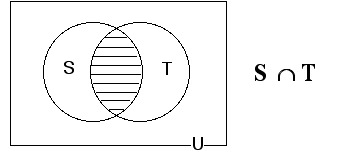
Suppose we merge all of the elements of A with all of the elements of B to form a single, larger set:
{ Citizen Kane, Casablanca, The Godfather, Gone With the Wind, Lawrence of Arabia, The Godfather Part 2, The Wizard of Oz, To Kill A Mockingbird}
This new set is called the union of A with B, and is denoted: ![]()
List the elements of ![]() .
.
In general, for any sets S and T,
![]()
The shaded region of the Venn diagram below corresponds to ![]()
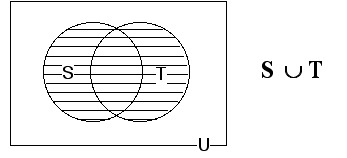
SET INTERSECTION, SET UNION, SET COMPLEMENT: SUMMARY
The intersection of two sets denotes the elements that the
sets have in common, or the "overlap" of the two sets.
![]()
The union of two sets merges the two sets into one "larger" set.
![]()
The complement of a set consists of all elements in the universal set that are not in the given set.
![]()
Who's to blame?
EXAMPLE 1.2.1
For problems 1 - 10 refer to these sets:
U = {a, b, c, d, e, f}
A = {a, c, e, f}
B = {c, d, e}
C = {e, f}
Find each of the following:


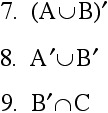
![]()
see solutions for 1 - 10
World Wide Web note:
For more practice exercises involving set operations, visit Mr. Wooland's home page and try
The BIG OPERATOR
Note: In problems 11 - 16 that follow, the sets A, B, C and U are not the same sets that were used
problems 1 - 10. These problems are to be solved in general, not by referring to specific sets whose
elements are known.
11. On a Venn diagram, shade the region(s) corresponding to ![]() .
.
12. On a Venn diagram, shade the region(s) corresponding to ![]() .
.
13. On a Venn diagram, shade the region(s) corresponding to ![]() .
.
14. On a Venn diagram, shade the region(s) corresponding to ![]() .
.
15. On a Venn diagram, shade the region(s) corresponding to ![]() .
.
16. On a Venn diagram, shade the region(s) corresponding to ![]() .
.
Solution to Example 1.2.1 #13
To shade the set ![]() we need to compare the Venn diagram for A with the Venn diagram for
we need to compare the Venn diagram for A with the Venn diagram for ![]() , and bear in mind the meaning of union.
, and bear in mind the meaning of union.
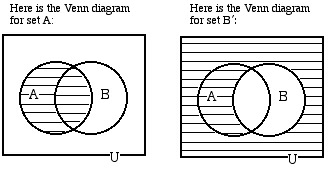
We combine these two Venn diagrams using set union. This means that any region that is shaded in either of the diagrams above will be shaded in ![]() :
:
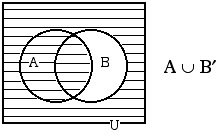
The preliminary work that was employed to solve problem #13 will also allow us to solve #14.
see solutions for 14 - 16
EXAMPLE 1.2.2
Let U = {1, 2, 3, 4, 5, 6, 7, 8, 9, 10}
S = {2, 5, 7, 9}
V = {3, 4, 5, 6, 7}
T = {1, 3, 4, 5, 8, 9}
Find

see solution
DeMorgan's Laws for Set Mathematics
For any sets S, T:
![]()
"The complement of a union is the intersection of the complements."
![]()
"The complement of an intersection is the union of the complements."
Who's to blame?
EXAMPLE 1.2.3
Shade the region(s) of the diagram corresponding to:



see solution for #1
see solution for #2
see solution for #3
see solution for #4
see solution for #5
see solution for #6
Who's to blame?
WORLD WIDE WEB NOTE:
For unlimited practice involving three-circle Venn diagram shading problems, visit Mr. Wooland's
home page and try
MY COUSIN VENNY
Download practice exercises (PDF file)